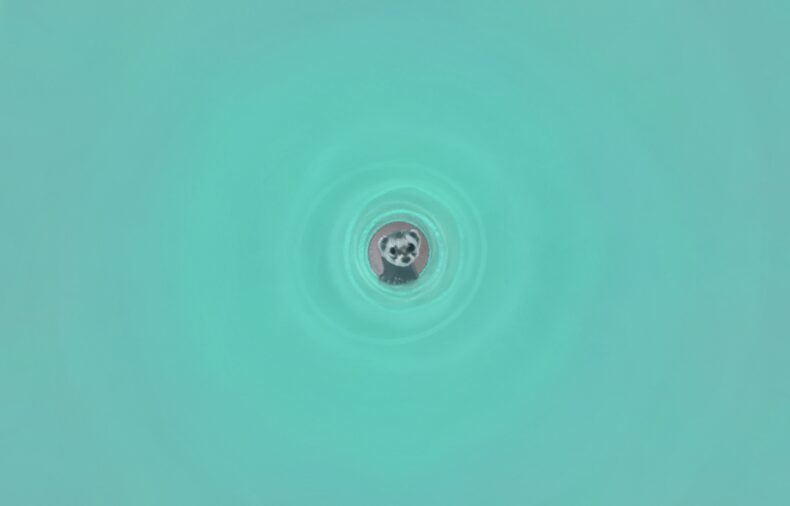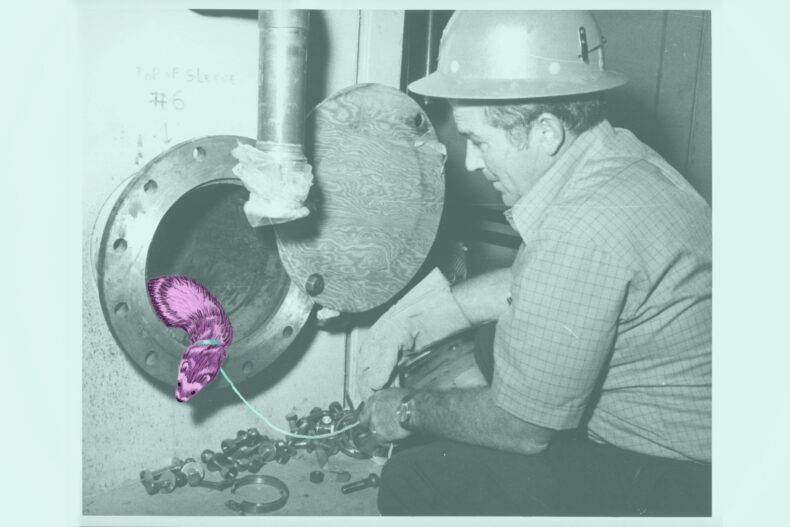
For years, now, I’ve had a scrap of digital paper on my computer desktop with four words on it: Felicia, the Fermilab Ferret. A memorial to an extraordinary life. A reminder to channel the legendary little animal’s spirit into something strange and new. Little poems, perhaps. And, now, finally, I have.
But first: her story.
A long, long time ago (1971), in a magical place (rural Illinois), a team of scientists built a very, very large and very, very important machine (a particle accelerator). Geese migrating over the National Accelerator Laboratory could see the colossal ring of tunnels through which protons and antiprotons would soon zoom, zip, and collide. History-making was imminent.
But the machine didn’t work. Something was messing with the magnets. Eventually engineers identified the problem: tiny steel slivers left in the tubes during construction. All they had to do to fix the machine was clean out the tubes. But the tubes were miles long, and sealed, except for a narrow opening at each end.
Enter Felicia.
Fifteen inches from nose to tail, with sharp, sparkling eyes and a hunter’s mind, the little ferret was ancestrally primed for this kind of work. She came special delivery from a farm in Wisconsin. She cost $35.
The engineers fitted Felicia with a collar attached to a string and a custom-made ferret diaper to prevent her leaving her own particles behind. The plan was that Felicia would enter the tube and scamper along its length, impelled into the unknown by the sheer animal joy of exploration, dragging the string behind her and emerging at the other end. The engineers would then attach a swab to the end of the string and pull it through, capturing all remaining metallic debris along the way.
The human-ferret team started small, with shorter sections of tunnel, and built their confidence, trust, and affection. In the beginning, Felicia spent her nights at a mink farm a few towns away. As time went on, some of the engineers began bringing Felicia to their own homes. They doted on her, and fed her treats; her favorite were chicken livers, fish heads, and hamburger.
Felicia’s physics career was relatively brief, at least in human time. After only a year or so of the ferret/string/tunnel/fish-head method, technicians invented a mechanical ferret that didn’t need a diaper change or a ride home after work.
Felicia lived out her retirement as a house pet at the mink farm, continuing to enjoy regular home visits with her former colleagues.

It’s a heartwarming story, to be sure, but of course there was more to it. Don’t get me wrong: nothing especially sinister happened. Reality is just complicated.
When I think about Felicia, I think about instinct and wildness. I think about all her bunkmates at the mink farm who didn’t have adoring, if paternalistic, coworkers. I think about agency, and freedom, and what it means to feel alive.
at the farm this morning, as most mornings, i am fixed by six thousand like-mine eyes as i climb into a different box and am carried away. scent men’s hands, then metal. metal, metal, metal. then fresh snow—then metal, metal. then men’s hands again. tunnel what awaits on the other side no longer interests me. i’m more intrigued by the ghosts in the dark who’ve memorized my little songs and hum to keep me company. hamburger i didn’t kill this. i have never killed anything. yet somehow i taste victory. the fat. the blood. at the farm (ii) he drops me off at sunset. the light is forest-fire red on the open door of my cage.
Drawings by me; original photographs from Fermilab. You can read more about Felicia here. For more Fermilab-inspired art, click here to listen to Sylvan Esso talking about their song “Ring.”
The fact-check/full transparency rundown:
1. The National Accelerator Laboratory would not be known as Fermilab until 1974, but “Felicia, the NAL Ferret” makes for a far less punchy title.
2. At the height of its success, the Winfield mink farm was home to 10,000 animals. I cannot find any data on how many animals lived there in 1971, so I went with whatever sounded best in the poem.
3. No recordings of Felicia singing to herself in the tunnels exist, but that doesn’t mean she didn’t do it.
4. I don’t know how echoes work–unlike Felicia, I am not a physicist–but I’m pretty sure her voice would have bounced ahead and multiplied, building a faint and friendly chorus of ghostly companions.
5. Felicia may have killed something at some point. I like to think she did.
6. Ferrets can see red. I checked. In fact, red may be the only color they can see. (Some sources say they can also see blue.)
7. It is extremely unlikely that Felicia ever witnessed a forest fire. I know, I know. Please just let me have this.
I am drawn to the alliteration in _Felicia, the Fermilab Ferret_, so on one level I agree _Felicia, the NAL Ferret_ is not as good. But: _The Rats of NIMH_ became a famous title, so … *shrug*
Kate,
Each time you write you take me to worlds I never considered. You expand my horizons with your insight, wit, humor and perspective. You leave me breathlessly hoping for more because it seems to flow seamlessly from your spirit.
Kate, I love everything about this. You’ve made me put myself in Felicia’s place, and I love her now.
Who knew? A ferret was responding to a twitter post 0n January 2019 about an Earth upper atmosphere disturbance & calling it Betelgeuse farting
The Weather has not been long range traceable since then